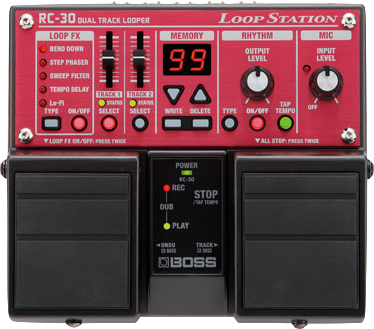
How to sync Boss RC30 looper to any tempo
This trick also works for other loopers on which you can store audio files. So read on and see if your looper can do this too.
The Boss RC30 is an amazing looper. Easy to use, almost unbreakable…. But if you want to use it in a hardware synth setup it’s very hard to sync it up to your main clock / tempo. You have to try and make the loop exactly the right length manually because there is no way to sync it via midi. But this is very hard and even if you are as close as you can get the loop will go out of sync eventually. Making you have to stop and start the looper which will most likely result in the looper being even more out of sync.
But if you’re using the method I will describe below you will be able to keep the looper in sync for a long period of time and also the looping process will get a lot easier. I use this method myself to sync up my guitar loops to my Electron Octatrack or Roland SP404.
What do you need to make this work:
- Boss RC30 Loop pedal
- Master Clock device you want to sync the looper to (Electron Octatrack, Korg Kaosspad, Roland SP404 etc)
- A computer and a way to record sound coming from your clock master into the computer
- Some Digital Audio Workstation (DAW) like Ableton Live, Logic (in this tutorial we use Ableton Live)
The Process:
Make your master clock device play a sound on every bar (1, 2, 3, 4) at your desired tempo. Some devices like the Electron Octatrack have a built-in metronome. But for other ones that don’t (Korg Kaoss Pad) you just choose a sound that has a nice transient like a snare drum. This makes it easier to see if you are at the right tempo in your DAW.
Record this sound into your DAW for about 10 minutes. The result should look something like the picture below.

Now click on your audio file and make sure ‘warp’ (ableton live) or any time stretching algorithm is ‘off’. Now set the start point of your audio file to any of the transient hits after the 5th one. This helps you get the most accurate results as some devices need a little bit of time to get their clock stable.

Set the tempo in your DAW to the tempo you had on your master clock device. If you now check the end of your audio file you will probably see that the sound isn’t lined up with the grid like in the picture below. The amount of drift differs per device. I found myself that the Octatrack has a pretty good internal clock and a Roland SP404SX clock is a lot less accurate.

The next step is finding the tempo that makes the transient sound line up with the grid. Ableton live normally only shows 2 digits after the dot, but it registers 3 digits after the dot. So use that to make the end result more accurate.

After some trial and error, we get the transient sound as close to the grid as possible.

The next step is deciding how long you want your loop to be: 1 bar, 4 bars, 8 bars? I normally end up making several lengths per tempo so I have them available if needed. Select the length you want and copy that part to another track. Go into the audio file and make the volume as low as possible. Now export this part in your prefered way.
Make sure you bounce it as a stereo file otherwise the looper will not recognize the file. Also, make sure ‘normalise’ is off! Give your file a name like OCTATRACK_LOOPSYNC_85BPM_4.WAV so you can instantly see what kind of file it is (85 bpm, 4 bars long).

Now connect your Boss RC30 or similar looper to your computer and copy the silent audio file in one of the empty looper slot folders. I normally copy it in the _2 folder so the first loop track is empty.
The cool thing about looping this way is also that it doesn’t matter when you start the recording as it will always loop round in your desired tempo.
If you don’t own a Boss RC30 or Boss RC3 looper yet and want to support our website. Consider buying one through the links below. You don’t pay any more than you normally would but we get a small fee from the seller.
Boss RC30 Looper: https://amzn.to/2ybun0H
Boss RC3 Looper: https://amzn.to/2LNl6Ou










